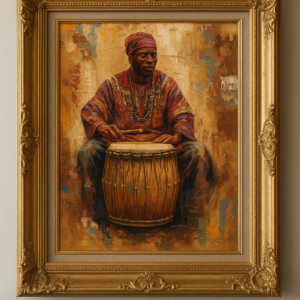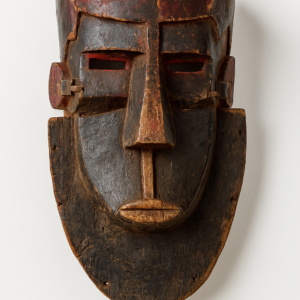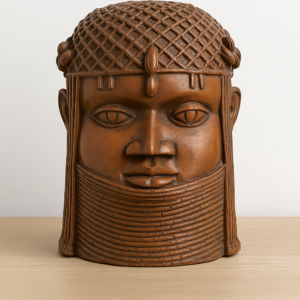“Likasa N’Kokolo,” meaning “The Spirit of Regal Ferocity” in a combination of Lingala and Kikongo—languages native to the Congo basin—is a masterfully crafted ritual artifact embodying ancestral strength, authority, and the wild force of nature. Emerging from the deep-rooted ceremonial traditions of the Yaka or Suku peoples of the Democratic Republic of the Congo, this towering helmet mask exudes a presence that transcends sculpture, functioning as a living spirit once activated through performance.
Crowned by a dramatic crest of carved antelope horns and an animal effigy—possibly a mythical forest creature or stylized buffalo—this piece proclaims spiritual potency from the first glance. It radiates sacred symbolism in every element, from its vertical height and carved facial mask to the voluminous raffia that engulfs it like a golden halo. As both protector and communicator of ancestral wisdom, Likasa N’Kokolo serves as a powerful reminder of the vital relationship between the natural world and the spirit world in Central African belief systems.
The headdress at the top is particularly striking. A circular disc painted with radial patterns in earthy ochres and faded indigo tones anchors a dynamic cluster of arched horns—sharply curved, animalistic, and forceful in visual motion. The use of horns in African iconography is common among warrior and protector spirits, evoking strength, defense, and spiritual alertness. Their placement in upward flight suggests a reaching toward celestial guidance, a visual metaphor for elevation, leadership, and wisdom.
Beneath this crest sits the face of the mask: a long, narrow visage with pronounced cheekbones, closed eyes, and a serene but commanding expression. Its features are stylized to evoke calm power—an elder’s patience with a guardian’s watchfulness. The surface bears light pigment traces, hinting at ceremonial use, smoke exposure, and traditional coloring techniques. These subdued tones preserve the mask’s timeless dignity and resonate with its intended sacred function.
Surrounding the entire structure is an immense, full-body raffia cloak, hand-stitched and fiber-woven from the leaves of the raffia palm. The raffia is not mere adornment; it plays a critical role in masking the dancer’s identity, concealing the human form to transform the wearer into a spiritual entity. The way it falls from crown to ground adds volume, movement, and auditory presence—each step and spin causing it to rustle, sway, and whisper like the spirits of the forest.
Helmets like Likasa N’Kokolo are not passive masks; they are avatars of justice, healing, initiation, and sometimes even punishment. In Yaka and Suku societies, such pieces are typically worn by members of secret male societies or by appointed elders during highly choreographed rituals. These rituals mark the passage from childhood to adulthood, honor ancestors, or affirm communal law. The mask, therefore, holds both spiritual and judicial power—serving as a witness, a judge, and a vessel of ancestral energy.
The craftsmanship is notable for its technical excellence and spiritual intentionality. Each angle, carving, and pigment choice aligns with a deeper narrative about harmony, transformation, and identity. The horned crown may also serve as a symbolic compass, guiding the spirit medium during ritual dance. Meanwhile, the tightly drawn facial planes evoke the composure of a sage, someone who bridges chaos and order.
Despite its ritual depth, Likasa N’Kokolo adapts beautifully into a modern interior context. In a curated gallery, luxury loft, or cultural heritage space, it stands as an icon of heritage, bold design, and narrative sculpture. Its raw natural fibers contrast beautifully with contemporary materials, and its vertical stature makes it a commanding centerpiece.
As an artifact, Likasa N’Kokolo carries the dignity of lived use. Its light weathering, scuffing, and pigment fading are not flaws but history—proof of its role in dance, invocation, and performance. These marks transform the piece from art into archive, from object into oracle.
For collectors, curators, and spiritual aesthetes, this is more than a mask—it is a conduit. A living memory carved in wood and fiber. A guardian spirit waiting in stillness, ready to speak through space and time.





Reviews
There are no reviews yet.